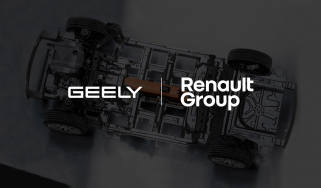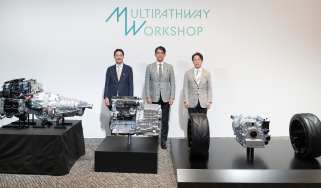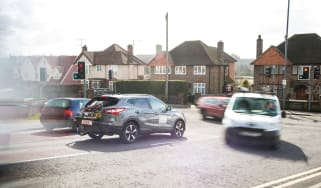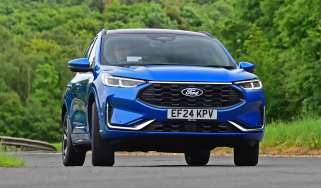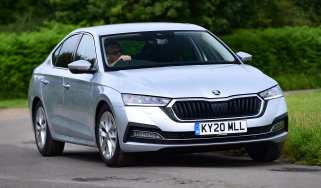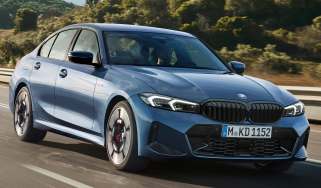‘Wake up to hydrogen and other EV alternatives’, Ineos boss tells government
The Ineos Automotive CEO hits out at the EV-only approach to net-zero, saying “drivers have been left behind”
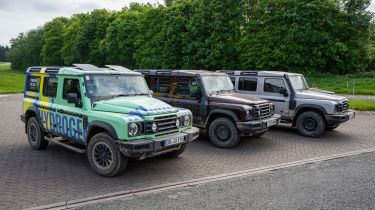
The government’s battery-EV only approach to decarbonisation has “left drivers behind” and is likely to fail, says the chief executive of Ineos Automotive Lynn Calder.
The Ineos boss was speaking at a ‘road to decarbonisation’ event this week, where the company allowed first media drives in a hydrogen fuel-cell powered Grenadier off-roader prototype, which it says provides one alternative pathway to decarbonisation that could be on sale in the next decade. In the much nearer future, Ineos is also planning a range-extender hybrid version of its recently announced Fusilier off-road EV, which will feature a smaller battery with an onboard internal combustion engine for charging purposes, allowing it to operate independently of charge point infrastructure networks. The range-extender is effectively a hybrid, which is tech currently set to be banned for new cars from 2035, but Calder says a realistic pathway to decarbonisation needs to take the public with it, and suggests the current ZEV Mandate is deaf to the desires of drivers.
“We all understand the targets that we've got to achieve and take it very seriously. It’s just about how we get there. And I think with a single horse that we're trying to back at the moment in the form of electrification in this country, and in Europe, I think we're going to fail,” she says.
“We see consumers voting with their feet at the moment. The Government has said ‘the market has spoken and the market wants electrification’. I think we can see with the sale of electric vehicles at the moment, the market has not spoken.”
Calder also flagged up the slow roll-out of charger infrastructure. “They [the Government] said that private industry would sort out the infrastructure, it would invest in the infrastructure required at the pace required to fulfil net zero targets with a solely electrification technology platform,” she said. “The private sector has not done this, certainly not at the pace required.”
According to Calder, one of the critical failure points in the Government’s ZEV Mandate strategy is the lack of engagement with drivers.
“Drivers are the cohort that has been completely left behind in this conversation”, she says. “Where's the driver in all of this? There are a great many things that people use their cars for and we need to provide technology solutions to all of those.”
“So what we're here to talk about today is having the government contemplate a multi-powertrain strategy, not dictating what the technology strategy should be, not a one horse race.”

According to Calder, as a relative newcomer to the auto industry Ineos brings a fresh perspective. “As someone with fresh eyes, you come and look at what the government in the UK and indeed the European Union has set out as a plan to decarbonisation. And that is on one technology platform, which is electrification for pretty much all use cases. I think it's gonna take a multiple solution, a multi powertrain strategy for this to work, and that is not where we sit today in either the UK or Europe.”
EVs absolutely have a place, but the CEO also points to the development of range-extender hybrids as “hugely important transition technology” that is currently ignored by government. “A vehicle which takes away a hundred percent of the range anxiety and also takes away 70-80% of the carbon emissions should be classed as an excellent transition technology,” she says.
“Hydrogen also has a special place,” according to the Ineos boss, and while acknowledging the “significant infrastructure challenges” she says it would be “an excellent propulsion system for a net-zero Grenadier”.
Calder claims battery power is impractical for the Grenadier as the weight would be prohibitive, and with a vehicle use case involving “heavy off-road, potentially in the middle of nowhere, or towing, it really doesn’t work as an EV”. The hydrogen fuel-cell option “does everything a Grenadier does, but in net-zero form”.
Ineos Automotive is a spin-off company of chemical giant Ineos which produces nearly half-a-million tonnes of ‘grey’ hydrogen every year through its refining operations. This gives the company a unique perspective on the prospects of hydrogen as a potential fuel in road transport, but Calder does not appear prematurely optimistic about the potential of the UK to capitalise on a swift transition.
“This is not a big call to arms for hydrogen, because we think range-extender tech is where it’s at right now. But for the future Hydrogen is really important to us. We are willing to get around a table and talk to people, and if we could come up with a package of interesting incentives that would help us produce the amount of hydrogen the country needs, and a way to help convey it and provide the infrastructure, then I’m not saying no to that.
“I’m not saying to government ‘you’ve got to fix this’, I’m saying allow the industry to innovate. Don’t just choose one technology, let the stakeholders get together, and we could make a really good plan of how we’re going to achieve this”.
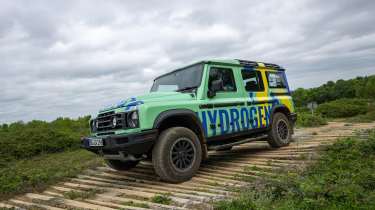
Driven: Hydrogen fuel-cell Ineos Grenadier
If it wasn’t for the Hydrogen graphics plastered over the bodywork, you’d be hard-pressed to tell there’s anything unusual about this Ineos Grenadier. The oversized bonnet bulge provides a clue, and the whirring drivetrain is an instant giveaway that you’re listening to a car powered by electricity.
But this EV is not one you plug in overnight, because to match the range and performance on offer from the hydrogen fuel cell it’s equipped with, would require a battery that would add an extra half-ton to this car’s 2,700kgs. Ineos doesn’t want to sell you a battery-powered off-roader that you can’t drive on a regular car licence, but it’s quite happy to contemplate selling you a fuel-cell powered EV (FCEV) that matches petrol and diesel performance - and refuelling times - without adding any appreciable weight.
Don’t get your hopes up just yet, though. While our brief drive off-road suggests a FCEV Grenadier will be equally capable and just as desirable as the BMW straight-six-powered petrol variant, you can count the number of hydrogen filling stations in the UK on the fingers of one hand.
Until that’s sorted, any FCEV passenger cars remain a pipe-dream here, albeit a dream that’s increasingly realistic in terms of the maturing technology. We drove a BMW iX5 FCEV last year that’s to all intents and purposes production-ready, and the Grenadier, while still clearly a development hack, uses the same core hardware to good effect.
So there’s a 115kW fuel cell stack shoehorned under the bonnet, a battery sitting in the boot (production variants would stow the battery under the boot floor), and three electric motors for drive. A single motor drives a basically standard locking differential on the front axle, while two motors take care of business at the back end, driving half-shafts that lie alongside a beam axle - a set-up that project engineering chief Pamela Amann describes as a variation on the De Dion axle theme.
Between the chassis rails, two carbonfibre hydrogen tanks hold 2kgs of gas each, but that would be upped to 6 or 8kgs in production to deliver a 300-mile range. Addressing concerns about durability, Amann tells us the tanks are so robust and stiff they could easily be used to strengthen the chassis itself.
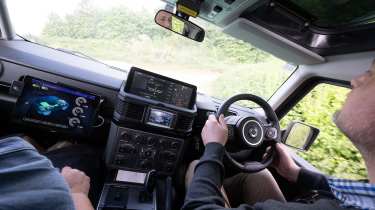
With no mechanical central or rear diffs, the FCEV Grenadier relies on electronic tech for functions such as hill descent control, via the brakes and a level of battery re-gen that produces enough retardation when lifting off the accelerator to allow one-pedal driving. Amann controls the systems separately via a remote touchscreen in the prototype, but for production she thinks a steering wheel paddle system is more likely.
There’s no doubting the power of the FCEV, which handled an extreme 60 per cent slope with aplomb in our short test, while the EV power delivery was arguably even more impressive than the already smooth response of the BMW-powered production variants. Under way, the silence of most of the powertrain highlighted a whine from the front differential that’s usually masked by engine noise, but Amann confirmed there’s been no work applied to the prototype from an NVH point of view. That will come on the journey to production, but for now the signs are that a Grenadier FCEV will have a similarly unflappable and capable character as its ICE siblings
Talking of production, Amann confesses she worked for Mercedes on its fuel cell projects directly out of University in 2002. “I was really young, and honestly thought the technology would be ready in the next five years,” she laughs. “It turned out not to be that easy, but I truly believe that hydrogen will be the most important energy storage system of this century.”
Hydrogen isn’t the only alternative to electric power, click here to find out more about synthetic fuels.



